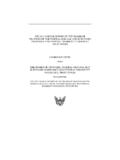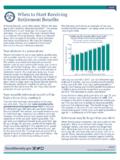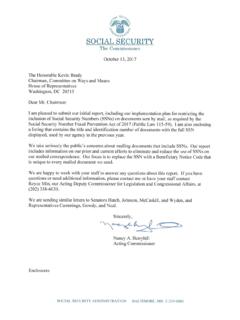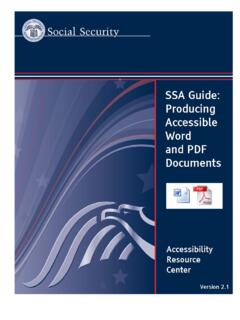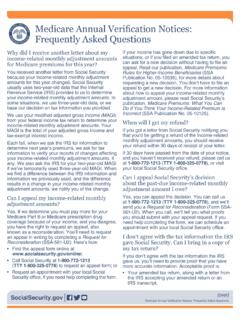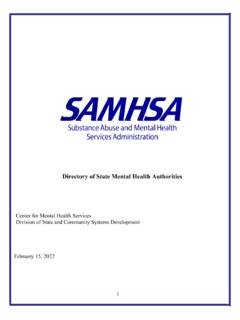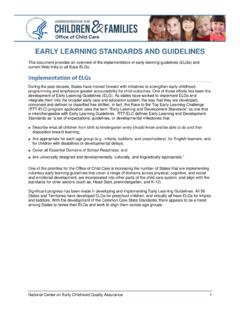Transcription of Medicare, Medicaid, and People With Disability
1 INTRODUCTIONWhen medicare was amended in 1973,expanding entitlement to People with dis-ability, it played a key role in promoting in-dependence and autonomy and enhancinghealth care for this population, which tradi-tionally had been underserved. Medicarerecipientswith Disability have been thefastest growing medicare -entitled popula-tion, and medicare , along with Medicaid, has had to adjust to meet the needs of thisever-changing group. Both programs mustcontinue to evolve to develop services de-signed specifically for People with , more than 6 million Americansunder 65 years of age with severe disabili-ties receive a vast array of medical, hospi-tal, support, rehabilitative, residential, andlong-term care (LTC) services throughMedicare and medicaid . These programshave contributed to the sea change in thenational attitude toward People with dis-abilities and promoted the independenceand autonomy of millions through the fund-ing of services that were non-existent andperhaps even inconceivable 30 years this article, we describe the historicimperative for publicly financed insuranceprograms for People with disabilities, thecharacteristics of medicare - and medicaid -eligible recipients with Disability , the arrayof services now available to them throughthese two programs, and lastly, obstacles toand opportunities for continued reform asthey present themselves , medicaid , and People with DisabilityRobert J.
2 Master, , and Carol Taniguchi, J. Master is President and Medical Director of Commu-nity Medical Alliance and Associate Professor of Health Serv-ices at the Boston University School of Public Health. CarolTaniguchi is with Community Medical Alliance. The opinionsexpressed are those of the authors and do not necessarily re-flect those of Community Medical Alliance, Boston University,or the Health Care Financing CARE FINANCING REVIEW/ Winter1996/volume 18, Number 2 WHY medicare AND medicaid ?Thirty years ago, People with severe dis-ability were for the most part nameless,faceless, and dependent on segregated in-stitutions or a myriad of distinct State gov-ernment or charity programs. Care was notan entitlement but a byproduct of whateverpublic generosity or charitable instinctsthat existed. Accordingly, services werehighly variable with respect to availability,quality, geography, and the Disability beingtreated (Scotch, 1984).
3 Traditions dating well back into the 19thcentury defined the institution as the hubof the care system for People with mentalretardation or mental illness and peoplewith physical Disability who were depen-dent. Thirty years ago, the values of equalrights,independence,andautonomy,whi ch are so prevalent today, had not yetcoalesced into a cohesive Disability -rightsmovement because of the pervasive cul-ture of dependency and paternalism, aswell as the fragmentation of the variousconstituencieswithdisabilities,wh ichlacked a unified political voice (Willis,1989). with this state of affairs, Social SecurityAdministration (SSA) surveys in 1960,1966, and 1972 comparing People with dis-ability to those without Disability could besuccinctly summarized as follows: Peoplewith Disability were poorer and had greaterburdens of illness, less private insurance,higher out-of-pocket expenses, and moreunmet needs (Krute and Burdette, 1981;Brehm and Cormier, 1970; Advisory Coun-cilof Health Insurance for the Disabled,1969).
4 A new financing mechanism wascalled for and clearly OF RECIPIENTSWITH DISABILITYIt is estimated that there are more than14 million People with severe Disability inthe United States under 65 years of age( of the Census, 1991). Ofthese, approximately 3 million are coveredby medicare through Social Security Dis-ability Insurance (SSDI, which covers per-sons with a permanent Disability that pre-vents employment) and adults over 22years of age disabled as children. An addi-tional million are receiving Medicaidbenefits by virtue of eligibility for Supple-mental Security Income (SST). Finally, about900,000 individuals receive medicaid ben-efits because of a persistent Disability thatprohibits employment. However, the latterare not eligible for SSI income paymentsbecause of income that exceeds the SSI eli-gibility limits ( center for Vulnerable Popu-lations, 1992; Lubitz and Pine, 1986).The estimated number of People under65 years of age with severe Disability andthe penetration of medicare and Medicaidas health service coverage for this popula-tion aresummarized in Table 1.
5 Fifty-sixpercent of medicare - and medicaid -cov-ered disabled recipients are male ( Bu-reau of the Census, 1989), and nearly 50percent have total income at or below thepoverty level (National center for HealthStatistics, 1990). Conversely, looking at theentire population, almost one-half ofpersons with incomes below $10,000 in1990 reported a significant Disability (National center for Health Statistics, 1990).Since the inception of medicare andMedicaid eligibility for People with disabil-ity in 1973, caseloads have grown on aver-age by 7 percent per year. However, thisgrowth has been uneven, with periods ofrapid growth before 1981 and after 1987( center for Vulnerable Populations, 1992).The expanding caseloads and high healthTable 1 Estimated Insurance Status of People WithSevere Disability : United States'A broader and perhaps less severe range of Disability than that re-quired for Social Security Disability Insurance (SSDI), SupplementalSecurity Income, or those adults disabled as children eligible for large percentage are also eligible for medicaid , not counted under"Persons Eligible for medicaid .
6 "3 Some medicare - and/or medicaid -eligible persons may also be re-ceiving Veterans Administration services as : ( Bureau of the Census, 1991).care needs are reflected in high healthcare costs. In 1993, medicare expendituresfor People under 65 years of age with dis-ability were $ billion (Health Care Fi-nancingAdministration,1995).Earlierst udies demonstrated that the average an-nual per capita health care costs for theMedicare-eligiblepopulationunder 65years of age with Disability were nearly 30percent higher than the costs of all elderlyMedicare beneficiaries (Lubitz and Pine,1986). In addition to medicare and Medic-aid spending for physician and hospitalservices, total Federal and State spendingon a subset of these total eligibles-through medicaid , State Departments ofMental Health, and residential, home care,and LTC services for mental retardation-totaled nearly $92 billion in 1991 (Centerfor Vulnerable Populations, 1992).
7 Because neitherMedicare nor StateMedicaid programs have historically keptdata on the reason for Disability , an exactongoing census of eligible populations withdisability by distinct clinical groupings hasremained elusive. A household survey of arandom sample of SSDI recipients who be-came eligible forMedicaid in 1973identified the prevalence of disabling92 HEALTH CARE FINANCING REVIEW/Winter 1996/Volume18,Number2 Population GroupEstimatedNumber(inMillions)PercentP ersons Under Age 65 WithSevere Disability ' Eligible for medicare Eligible for Eligible for as follows: cardiovascular andrespiratory illness, 40 percent; musculosk-eletal illness, 31 percent; mental illness, 10percent; and neurologic illness or impair-ment, 6 percent (Hardwick et al., 1994).Because the sample was limited to thoseliving independently, the MR/DD (mentalretardation/developmental Disability ) pop-ulation was likely undercounted. BrandeisUniversity's center for Vulnerable Popula-tions (1992) cites population-based surveysof Disability in the United States that iden-tify with MR/DD, millionwith severe and persistent mental illness,and million with severe functional im-pairments that could meet SSDI/SSI eligi-bility criteria.
8 However, it is unknown if thesame proportions are reflected in the sub-set of People with Disability who have be-come eligible for medicare and 1993, a far higher percentage of SSI re-cipients eligible for medicaid had mentalillness or mental retardation as the primarydisabling condition than SSDI recipientseligible for medicare . Twenty-nine percentreceived SSI/ medicaid because of severemental illness, 28 percent because of men-tal retardation, and 43 percent because ofphysical Disability (Drainoni, Tobias, andDreyfus, 1995). There are no available datadescribing the reason for Disability forMedicare-eligible adults disabled as chil-dren, but it is likely that mental retardationand developmental disabilities are the diversity of the medicare -and medicaid -eligible populations with dis-ability, clinicians, advocates, and policy-makers find common elements. Peoplewith severe Disability generally have ongo-ing predictable baseline needs for support,residential,or LTC services.
9 They havelower thresholds than the general populationfor an array of acute medical complicationsfor which considerable medical contact andrecurrent hospitalizations are required; andHEALTH CARE FINANCING REVIEW/ Winter1996/volume 18, Number 2any diminution or loss of support, housing,or LTC services often translates into in-creased medical or hospital OF NEW BENEFITSP erhaps the most significant conse-quence of medicare and medicaid entitle-ment for People with Disability has been therapid development of an entirely new andunique array of benefits and services de-signed to promote independence and au-tonomy. medicaid became the primary en-gine for this development. Today, despitelimitations, variability, and cost pressures,the State medicaid programs function asthe Nation's only formed Disability andLTC insurance program. Over the past 25years, through the flexibility that Stateshave had in the design and elaboration ofoptional benefits and the 2176 home andcommunity-based waivers, a de facto ben-efits policy for People with Disability hasevolved where none existed before.
10 Ex-amples of these new benefits include: ex-panded home health aide services forpeople with chronic Disability and/or per-sonal care attendant services in 29 States,licensed residential care facilities in lieu ofintermediate care facilities for the mentallyretarded and nursing homes for the men-tally retarded in 41 States, an array of 2176case-management, residential, and homecare services in lieu of institutional care in50 States and Washington, DC, and adultday health services in 30 States (Hardwicket al., 1994). The availability of these serv-ices by State and their expenditures aresummarized in Table a consequence, these entitlement pro-grams have been one factor contributing tothe substantial de-institutionalization thathas occurred over this period and havegiven a voice to previously voiceless disabledconstituencies in the advocacy for and designof services better able to meet their 2 Expenditures for Home and Community-Based Servicesand Services Available, by State: United States'Expenditures include all home health services, home and community-based services of personal care attendants, and home andcommunity service : PCA is personal care : (Hardwick et al.)
